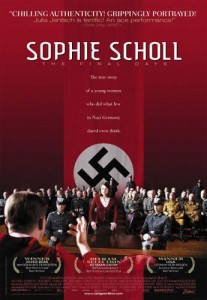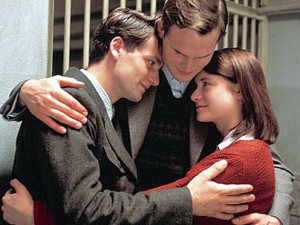Sophie Scholl-The Final Days constructs the events of the White Rose movement through the arrest, interrogation and eventual execution of Sophie Scholl (Julie Jentsh), Hans Scholl (Fabian Hinrichs) and Christoph Probst (Florian Stetter). The audio is in German with subtitle options and is a heart wrencher — tissues recommended!
2005, Directed by Marc Rothemund
The testimonies of the Scholls and Probst offer a glimpse into German resistance that isn’t widely known. In fact, one of the main arguments against the efficacy of nonviolent resistance is that nonviolent tactics would not have worked against the Nazi regime. The White Rose movement, along with several others like the Rosenstrasse protest (a successful occupation by German spouses of Jews outside a detainment center in Berlin) and the Saint of Auschwitz (a Catholic priest, who among other things, volunteered to die in place of another prisoner in Auschwitz),and the contemporary Red Orchestra in Berlin, which also distributed leaflets, are examples of successful resistance against the Nazis.
The film is sprinkled with powerful flashbacks that collectively form the context in which the White Rose movement was born. Throughout Sophie’s interrogation, we learn about her unwavering will and determination to expose the reality of Germany under Nazi rule. The Nazi
political machine was very successful in creating consistent propaganda that manipulated German pride and nationalism to solidify its ideology. We also see the circumstances under which the White Rose operated: They were completely underground, hand printing all their leaflets in a loaned warehouse, anonymously distributing the leaflets in mailboxes all over . In total, the movement successfully distributed six leaflets. The last leaflet was airdropped by Axis forces posthumously, presumably reaching every house in Germany.
In 1945, war sentiment in Germany started to wane as it became apparent the Axis could not hold the military front much longer. Nazi rhetoric and denial of the impending loss was consistent, strong, and unwavering. In a scene during the trial by the Nazi war tribunal, the extent of Nazi propaganda was apparent. Amidst proof of Axis military defeat, the tribunal vehemently denied the situation, explicitly stating war would be Germany’s saviour. The White Rose chose an opportune moment when citizens were apt to start questioning Nazi ideology to redefine nationalism and regain a wholly German identity.
“Better an end in terror than a terror without end.”
The film left me pondering the effects of the White Rose Movement, and how success can be measured in ways other than the measurement of how much power is taken away from the adversary. While it is clear the White Rose movement did not have a direct effect on ousting Hitler and the Nazi regime, it was successful in achieving its stated goals, which Sophie Scholl said was “to inspire and inform Germans”. The value of inspiration on a depressed population cannot be quantified, and one of the main points made in the film is that it has tremendous value.
“How can we expect righteousness to prevail when there is hardly anyone willing to give himself up individually to a righteous cause. Such a fine, sunny day, and I have to go, but what does my death matter, if through us, thousands of people are awakened and stirred to action?”
-Sophie Scholl-The Final Days.
There is one main resounding impact the Movement did have- providing a visible opposition of German led nonviolent resistance to the Reich; that in and of itself is so important. In a society where government has successfully reduced community in its society, people may not think resistance is an option because they feel isolated; as if they are the only ones questioning, the only ones opposing. The White Rose sought to reach out and unite Germans through leaflet dialogue. To be able to create solidarity is essential to preparing a foundation for resistance. Encouraging citizens to join resistance in any way they can is also essential in a separated society.
Today, the White Rose movement is remembered with memorials in Berlin, Munich and surrounding towns. In addition to memorials at the
Scholls residence and graves, there are various streets and schools named in memory of members of the White Rose. The German Resistance Memorial and Museum has a permanent White Rose exhibition.
The White Rose not only lives on in memory, but in some of its surviving members. It was previously thought that all known members had been rounded up by the Gestapo, but it is now known that some members have survived. In one instance, the Gestapo came for a member, a chemistry student, who happened to be out sick, and upon questioning, her professor was able to use his credibility to convince the Gestapo she was not involved– risking his life to save hers. She went on to become a member of the Bundestag.
Another survivor, Ms. Suzanne Zeller-Herzel, went on to be involved with the People’s Movement PAX Europa in Germany.
Further Reading on the White Rose Movement and the film:
Leaflets by the White Rose Movement
The White Rose Munich 1942-1943 by Inge Scholl












